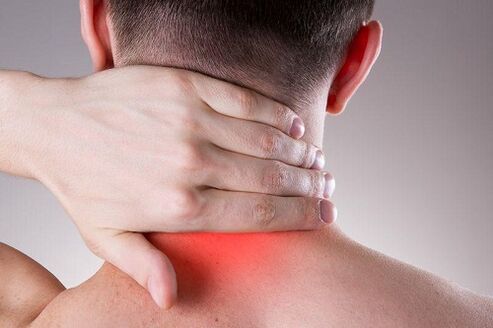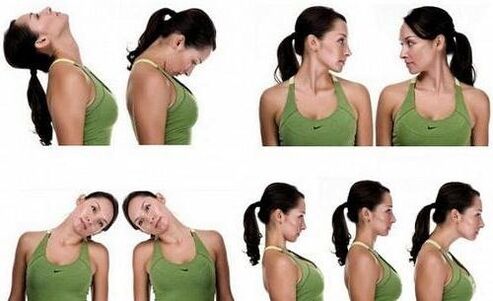Cervical spine osteochondrosis (trade) is one of the most common pathologies of the musculoskeletal system.Every year, doctors diagnose this disease more and more often and it is more and more severe.According to statistics, degenerative-dystrophic changes in the upper spine are more common in women, especially for patients during post-emprovation.The main symptoms of cervical osteochondrosis in women are pain, limitation of mobility, cerebrovascular failure, and this is dangerous not only for health but also for life.To protect against dangerous consequences of the pathology, you need to start treatment at an early stage.It is important to take a comprehensive therapy, change your lifestyle to stop the destruction of the vertebrates and prevent serious complications.
The development of the disease
The cervical spine is most vulnerable to various injuries and degenerative changes.This is due to the fact that this segment is most mobile and the muscles are weak here.Small cervical vertebrates can withstand a strong load daily, leading to the gradual destruction of the intervertebral discs.The vertebrates cause each other to press, causing cartilage gaskets to lose a lot of fluid, begin to degrade and deform.
In addition, osteochondrosis of the cervical spine develops due to inadequate nutritional nutrition.And in this area the spinal canal is narrow, so it often contracts, causing neurological symptoms.
In the early stages, the pathology in women is manifested by weight, capture, etc.Often, patients prescribe the first signs of the disease with excessive work.
Large amounts of blood vessels and nerve roots are located in the neck, and neurological disorders can also occur by compression.This is especially dangerous if a deformed disc or vertebrate contraction of the spine artery, which nourishes important parts of the brain.During compression, coordination of movements is a violation, a woman can lose weight, her vision, hearing worsening, and the risk of stroke increases.
Reference.According to statistics, cervical osteochondrosis is most common in patients from 25-40 years.This is caused by a decrease in the mass of physical activity, the work of the session.In women, the disease is more common than in men because they have more fragile vertebrates and thin bone tissue.
Doctors distinguish between 4 stages of osteochondrosis store:
- Stage 1 - The intervertebral disc loses part of the moisture, its height is reduced, cracks may appear on the fiber rim (outer membrane).This is the stage of cervical chondrosis, which is difficult to detect because it has unused symptoms.The neck is tired quickly, discomfort, severity in the damaged area, sometimes a slight pain arises, which passes quickly.
- Stage 2 - Cracks on the disc on the disc, the pulp core (disk gel -like contents) has been replaced and can be removed through the damaged areas.Thus, cartilage prolongs are manifested, which can compress the spinal cord and its roots.Periodically, pronounced pain, weakness, limitation of mobility, face, neck, shoulders, hands can occur.
- Stage 3 - Protrusion is dissolved by the outer membrane of the disc, so the hernia is formed.The pain becomes more pronounced, there are neurological disorders.
- Stage 4 - The disc is almost completely destroyed, the vertebrates are opposed to each other, bone growth (osteophytes) appears on their parts designed to stabilize the damaged segment.Nerve endings, spinal cord, blood vessels disrupt.Damage to neighboring funds begins.Clinical signs are pronounced.
The easiest to stop degenerative dystrophic changes in the first two stages of chopochondrosis.In 3 stages, comprehensive treatment will help to stop further destruction of the spinal segment.At the last stage, you can't do without surgery.
Causes
Schop osteochondrosis is a difficult and prolonged process that most often has several reasons.In most cases, the pathology is due to a seductive lifestyle, improper nutrition and metabolic disorders.Often the disease occurs due to injuries, or due to the natural aging of the body and weakening its protective forces.
Doctors distinguish between the main causes of osteochondrosis in women:
- Disruption of metabolic processes.
- Passive lifestyle.
- Genetic predisposition.
- Chronic muscle tension around the cervical segment.
- Bend the posture.
- Deficiency of fluid and nutrients in the body.
- Long -term stay in an uncomfortable position (neck closed and back).
- Excessive weight.
- Frequent wearing in heels.
- Shop injuries.
- High objects rise.
- Autoimmune pathologies.
- Frequent stress, chronic fatigue.
- Hypothermia.
- Infectious diseases.
- Very long or short neck, etc.
All of these factors provoke the nutritional disorders of the intervertebral discs and cause degeneration.
Cervical osteochondrosis of a woman's cervix can be caused by abnormalities of the spine artery, which is associated with genetic predisposition, intrautherious disorders, and injuries during childbirth.The disease can occur due to rheumatism, endocrine disorders, and overloading of the cervical segment during pregnancy, local overload.
Important.The main causes of cervical osteochondrosis in women are menopause as well as changes in this period.At this stage, the concentration of progesterone in the body is reduced, which is very important for bone tissue.The likelihood of degenerative changes is associated with weakening of the age of the neck muscles and weakening the spine support in this area.
Symptoms
Osteochondrosis is characterized by a wave -like course when the acute period is replaced by remission.Exacerbation can cause infections, injuries, hypothermia, long loads on the neck.

The first signs of cervical osteochondrosis in women are headaches, discomfort, and severity of the neck.It is important to distinguish it in a timely manner to distinguish pain from chondrosis from migraine or autonomic dysfunction.
Clinical manifestations of osteochondrosis in women are caused by neurological syndromes:
- Cervical discs are found in fragments of cartilage damaged by irritation of nerve endings.Then a specific crunch appears on the neck, the pain that becomes more pronounced when the head moves and after sleep.
- Muscle staircase syndrome results from the damage to the shoulder plexus and subclavial artery vessels and nerves.The complex of these symptoms is accompanied by pain from the inner surface of the shoulder to the damaged hand.The limb becomes pale, cool, swollen, bumps.The pain in the neck extends to the back of the neck when the patient turns his head.
- Shoulder - Pertrose Syndrome - Dystrophic changes affect the tendon fibers that surround the shoulder.Painful sensations radiate from the neck to the shoulder and shoulder.There is a forced position of the neck - it is prone to the affected side, and the shoulder slightly decreases.
- Spinal Artery Syndrome - Compression of blood vessels with fragments of damaged disc or osteophytes (depending on the stage of the disease).The patient spins and headache, nausea, and sometimes vomiting.The pain is localized in the back, crown and temples.
- Cardiac - Nerve beams of the spinal cord are damaged.There is heart pain, arrhythmia.In case of C3 injury, the pain appears in the neck, the tongue is swollen, the patient cannot normally chew.If the C4 is injured, then the discomfort arises in the area of the shoulder herbs, the collargon, the heart.With C5 injury, the pain from the neck extends to the shoulder, on the inner surface of the shoulder.C6 irritation is manifested by pain from the neck and shoulder to shoulder to shoulder and extends across the finger to the finger.If the C7 is damaged, the pain syndrome extends to the back of the shoulder herbs, grabbing the entire hand, including the index and middle finger.When C8 compresses, the pain extends from the affected area to the elbow and the little finger.
Also, a woman may be concerned about the emotional field, arise weakness, she becomes anxiety, touch.Often there is insomnia, memory is weakened, attention because of regular headaches.
Symptoms of cerebrovascular circulation disorders arise when a woman suddenly throws her, pouring it or performing a job in which her hands and cervical spine load is loaded, for example, when she is cut, she paints her gravity.
Disruption of cerebral circulation is manifested by dizziness, trembling walking, "flying" in front of the eyes, noise in the ears, weakness, nausea.In some patients, the sound is broken, sometimes it disappears, and the pain in the throat appears.
Osteochondrosis during menopause is accompanied by migraine, which is enhanced by sweating in the body and shoulders.When the spine is compressed, the cardiovascular system is disordered.
If the disease occurs for a long time, then there is a lack of blood circulation that perform neuro-endocrine functions.Due to the increased permeability of the blood vessel walls, atherosclerosis of the brain and heart arteries develops.

Diagnosis
If you notice symptoms of osteochondrosis, then go to the therapist.After visual examination, the specialist will take you to an orthopedist, spine or neurologist.
The following methods are used to diagnose cervical osteochondrosis:
- X -Ray allows you to find out that the patient has vertebrates in the patient, osteophytes are present at their edges, the distance between the vertebrates is reduced.To do this, the study is carried out in various planes.To get the details of the characteristic changes, the doctor takes the purpose of the pictures.
- CT CT CT detailed information on abnormal changes in the vertebrates.This method allows you to get volumetric images for more detailed research, it is used in severe diagnostic cases.
- MRI is used to accurately assess the condition of soft tissues (nerves, blood vessels, ligaments, muscles) on the affected side.
- Electromyography allows you to check the conduction of nerve fibers.
Doctors may also prescribe UZDG (ultrasound dopplerography of the main arteries of the brain) to determine the blood flow condition in this area.
Conservative treatment
In early stages, women with osteochondrosis can be treated at home.However, the doctor should compile a doctor.It is important to understand that it is a long process and is unlikely to be completely healed (especially older women).
The composition of the complex treatment includes:
- Taking medication.
- Using orthopedic devices.
- Therapeutic gymnastics.
- Physiotherapeutic procedures.
- Massage, manual exposure.
- Alternative methods of treatment.
Conservative techniques will help to stop pain, inflammation, normalize muscle tone, improve metabolic processes, feed the damaged segments of the spine.Timely therapy can stop abnormal changes.

The cervical osteochondrosis remedies will help to get rid of inflammation and pain.
In women, cervical osteochondrosis is treated using medications that will help improve metabolism of cartilage gaskets between the vertebrates, stop inflammation, pain.The following medications are used for this purpose:
- NSAID.Inflammation and pain of moderate or moderate power can help you release.
- Analgesics.Stop the pain syndrome.
- Preparation for improving cerebral circulation.
- Musodes help eliminate muscle spasms.
- Chondroprotectors.They help to stop the discharge of discs, improve metabolic processes, accelerate recovery.
- Majesty -based medicines.
- Nootrops.They stimulate the functioning of the brain due to the normalization of its blood flow, have a moderate sedative effect.
Reference.With intense pain that is not suspended by oral medications, such as therapeutic blockade, such as the solution of novocaine or NSAIDs.
You can complete treatment with anti -inflammatory and painkillers in the form of gel, creams and ointments.They will be effective in remission stage or with oral agents.
The decision to choose the healing combinations will be taken by your doctor.The specialist will develop a drug diagram and also determine their dose.It is important to follow its recommendations, as many of the above medicines endanger dangerous complications.
In the acute stage of osteochondrosis, the woman should abandon heavy physical activity.To unload the cervical segment, you need to wear a special corset (shantsa collar) that will fix the vertebrates in the correct position.This device is recommended to be used for prolonged seating or heavy physical work.
Physiotherapeutic procedures will help weaken the pain and improve blood circulation in the affected area:
- Diadinomotherapy.
- Magnetotherapy.
- Electrophoresis.
- Electrical analgesia.
- Ultraviolet irradiation, etc.
The therapeutic effect is manifested after the third session, then headache, hearing disorders, vision, dizziness, sleep and general condition improves or disappears.
Using submarine trimming of the cervical segment, you can expand the distance between the vertebrates, release the nerve or blood vessels from compression, and restore the normal position of the spine.
Massage normalizes muscle tone, reduces the flow of lymphatic fluid, causing swelling.After a few sessions, blood flow to the affected area improves.

Therapeutic gymnastics is one of the most effective methods for the treatment of osteochondrosis.LFK allows you to strengthen the weak muscles of the neck, which will then take part of the load from the spine and help stop or slow down degenerative-dystrophic changes.During lessons, blood circulation improves, metabolic processes, disk nutrition is accelerated, which has a positive effect on their condition.
Women should train every day.They consist of simple but effective exercises.The complex consists of alternately, in different directions of the head, as well as the movements of the neck during which the hands are used.These elements can be carried out at home, but only after a doctor's permission.Medical physical education is performed only at the stage of remission.
Complex treatment can be added to reflexology (acupuncture), hirudotherapy (leech treatment), swimming, etc.
Surgical treatment
The operation is prescribed at the last stage of osteochondrosis of the CHOP, which is accompanied by serious destruction of bone-cultural structures.Also, surgical intervention cannot be done if conservative methods were ineffective or the spinal canal is significantly reduced.
In the above cases, the anterior cervical discochomy is performed.During the procedure, the doctor immobilizes the damaged segment of the spinal column and removes the hernia that weakens the spinal nerve.Then the vertebrates, between which the disc is removed, is spent.If necessary, the space between the vertebrates is filled with a synthetic insert (cage).
After 3-5 days, the patient was released home.The rehabilitation period is about 12 weeks.To accelerate recovery, you need to take medications, wear a corset, manage the right lifestyle, go to physiotherapeutic procedures, and take exercise therapy over time.
Life recommendations
To get rid of unpleasant symptoms of osteochondrosis and stop degenerative-dystrophic changes in the cervical segment, you need to change your lifestyle.To do this, the patient must follow the following recommendations:
- Go to hiking daily, avoid running, jump and other explosive stress.
- You can't wear heavy objects.
- You can't sit for a long time, in extreme cases to wear a corset and periodically occupy a horizontal position.
- Perform special physical exercises for the back muscles at home.
- Sleep on an orthopedic mattress and a special pillow.
- Follow the diet, complete the diet with magnesium, calcium -rich products (nuts, dairy products, seafood, legumes), as well as vegetable fiber, chondroitin (jelly, jelly).Refuse fatty, fried, very salty foods, alcohol.Detailed information by your doctor recommends power rules.Either way, it should be correct.
Numbering cannot be allowed, warming will benefit in the absence of an inflammatory process.
Complications
In the absence of timely treatment of cervical osteochondrosis, a woman may feel the following results of the pathology:
- There is a probability of protrusion, which is transformed into a hernia after some time.Protrusion compresses the spinal cord as well as its nerves, causing neurological disorders.
- Osteophytes arise with severe disk damage, they irritate the spinal nerves and blood vessels.
- In advanced cases, it is possible to weaken the neck muscles or incomplete paralysis, then involuntarily hanging on the side or front.
- Compression of the spine arteries, disruption of blood flow to the affected side.This condition can cause neuralgia (pain along the nerve), hearing loss and vision.
- Paralysis (incomplete or complete) hands.
- Brain blow.
If a woman opposes this issue at an early stage of the store's osteochondrosis, then she will be able to warn the above conditions.
Preventive measures
Ideally, the prophylaxis of osteochondrosis of Chop is necessary during intrautero-development.The future mother should rule out factors that adversely affect fetal development: infections, oxygen starvation, intoxication.If there is a birth injury, then the newborn should undergo treatment.
To reduce the likelihood of developing chop osteochondrosis, the woman must follow the following recommendations:
- For example, stop the spine evenly, wear a load in both hands or in turn to the right, then to the left.
- Do not prepare too much weight.
- Try to avoid neck injuries, hypothermia.
- When working in the garden areas, rest every 1.5 hours, take 20 minutes to rest.
- Choose shoes with an elastic sole that soften shots during running or jumping.
- With a long seat, use a chair with high backs and dizziness or place on a corset.
It is also important to eat, to control weight, to prevent stress, to take vitamin preparations for medical reasons, to treat pathologies in a timely manner, which can lead to osteochondrosis.At the remission stage, it is recommended to visit sanatoriums to undergo a course of treatment.
The most important thing
As you can see, osteochondrosis of the cervical spine is more common than in men, as the first has more fragile vertebrates and a thin bone tissue.Patients are particularly susceptible to patients during the post -climacteric period.The disease is manifested by pain, neurological disorders, as well as dangerous symptoms of cerebrovascular accident.Treatment is recommended at an early stage to avoid dangerous complications of osteochondrosis.To do this, a woman should take medications, change her lifestyle, visit physiotherapeutic procedures, massage, do physiotherapy exercises.Surgical treatment is shown only in advanced cases.To prevent pathology, you should observe moderate physical activity, treatment with injuries and diseases, which can provoke osteochondrosis in a timely manner.


























































































